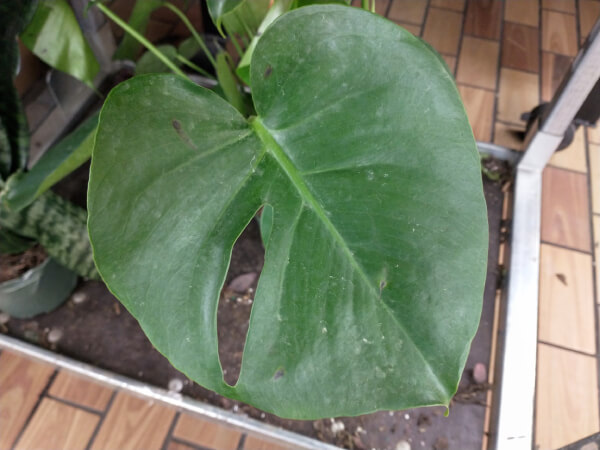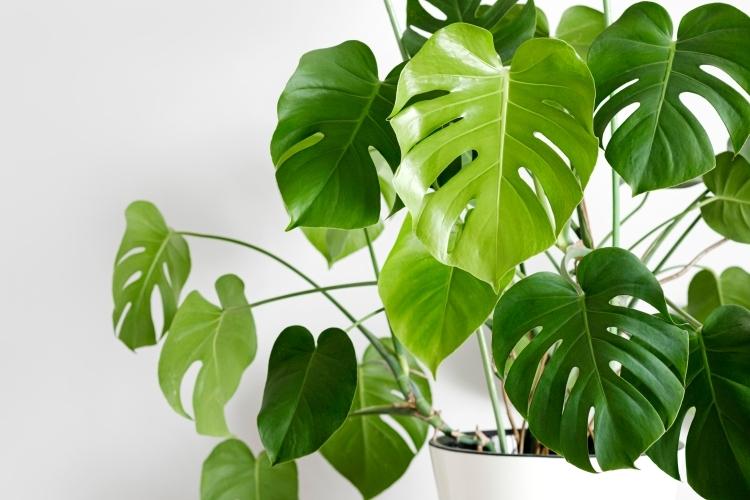When you think of Monstera, what’s the first thing that springs to mind? Those dramatic holey, deeply lobed leaves! But Monstera plants don’t start off their lives with that attention-getting leaf shape.
When do Monstera leaves split? It typically takes 2 to 3 years for these splits, or fenestrations, to occur, and they will begin showing up on new leaves. Existing leaves do not develop splits, and all the splits a leaf will ever have are present when the leaf unfurls.
In this post, you’ll learn more about when to expect those beautiful leaf splits to show up and what you can do to help your Monstera develop them as soon as possible. We’ll also look at why fenestrations happen in the first place and answer a few common questions. Let’s get started!
RELATED: Whether they have splits yet or not, Monstera leaves can take on a curled shape, which is usually a clue that something’s amiss with your plant. Visit our post on why Monstera leaves curl to find out the causes and how to fix them.
Table of Contents
When Will My Monstera Leaves Split?
According to North Carolina State Extension, Monstera is a rapidly growing broadleaf evergreen, and only mature leaves will develop splits and holes. A Monstera typically reaches maturity in about 2 years, although it can take up to 3 years. Before your plant reaches that milestone, it will only produce solid, heart-shaped leaves.
But once your plant reaches maturity, it will start producing leaves with a few fenestrations, and each subsequent leaf should have more holes. For instance, the first leaf to have fenestrations may only have one or two, while the next new leaf may have three.
However, age isn’t the only factor in determining when your Monstera will start pushing out fenestrated leaves- the environment also has to be right. If the lighting, watering, humidity levels, temperature and fertilizer factors aren’t quite right, it can slow down the maturation (and splitting) process.
The good news is that you have control over those environmental factors, and we’ll cover them in more detail a little later on.
How the Splitting Process Works
New monstera leaves are a lighter green color than more mature leaves, and it takes a good couple of weeks for each new leaf to unfurl. Monstera leaves are typically very large, approximately 1 to 3 feet long and up to 3 feet wide. Even immature monstera leaves start out pretty large (rolled up about 2 inches wide by 4 inches long) and will take several months to reach full size.
Monstera leaves do not develop any new fenestrations once they emerge from the stem, which means that each leaf unfurls with all the fenestrations it will ever have.
When your Monstera is just starting to produce fenestrated leaves, don’t look for those deep side lobes just yet. The lobes begin as fenestrations near the central leaf vein, and as the leaf continues to grow in size, the holes gradually move toward the edges as the leaf grows. Once they reach the leaf edge, they become a lobe.
Here are some photos that show the fenestration process:



How to Help Your Monstera Split Faster
Remember how I said earlier that your plant’s environment can affect how fast it develops splits and lobes? Here’s what you can do to help your plant mature and push out fenestrated leaves as soon as possible:
Plenty of Bright Indirect Light
Light exposure is the primary way you can help your Monstera grow (and thus, develop their leaf fenestrations) at the fastest pace. So if you have your Monstera tucked away in a dimmer area of your home, the fenestrations will probably take longer to show up.
Place your plant where it will get at least 5 hours of bright indirect light every day, and up to 10 hours is most ideal.
For those of us in the Northern hemisphere, a good spot is about 3 to 5 feet from a window that faces south. An east window is the next best choice, followed by a west-facing one. If all you have is a north-facing window, a plant grow light is a good supplement.
If you live in the Southern hemisphere, a north window provides the best light, followed by a west-facing one. An east window can also work, but you’ll need to add a grow light if you only have a south-facing natural light source.
Just be careful to keep your Monstera out of the sun’s direct rays. In its natural habitat, Monstera grows in the understory of the tropical rainforests, and the dense tree canopy filters much of the light. Because it’s adapted to these conditions, your plant could suffer damage if it gets too much direct sunlight.
Provide Good Overall Care
Monstera doesn’t require a high level of care, but there are a few basic requirements that need to be addressed and maintained for your plant to stay happy and healthy:
Water. Monstera is native to areas with well-draining soil, and it prefers to dry out a bit between watering. Water only when the top 2-3 inches of soil feel dry when you stick your finger into the soil.
Also, take a moment to dust the leaves with a damp cloth every time you water. Large plant leaves can be dust magnets, and wiping them off will make the leaves pretty and shiny and also help with photosynthesis.
Fertilizer. As a fast-growing plant, Monstera appreciates getting a regular dose of nutrition in the form of a balanced houseplant fertilizer. Every 2 weeks during the spring and summer months, give a half-strength dose of standard houseplant fertilizer or use a special Monstera formula.
But hold off on your fertilizing routine in the fall and winter. Your plant goes into a dormant, or resting, phase, where growth (and nutritional needs) slow dramatically.
Temperature. Monstera grows naturally in the tropical parts of the world, and it prefers room temperatures between 60 and 85 degrees Fahrenheit. So make sure to keep your plant away from chilly windows in the winter or blasting AC vents in the summer.
Humidity. Monstera is a fan of humidity, so consider spritzing the leaves with a fine-mist spray bottle or setting up a humidifier.
RELATED: We’ve put together a list of our favorite plant humidifiers for a variety of room sizes and needs. Stop by to learn more!
Have Patience
It’s hard to wait, but the most reliable way to help your Monstera with the splitting process is to just give it time. The older and bigger your Monstera gets, the more fenestrated and lobed leaves it will produce.
Holes or not, Monstera is a beautiful statement plant that grows quickly and brightens up any room. And solid leaves are simply a part of the growing-up process for Monsteras that are less than 2 years old.
But don’t worry- with the right conditions and time, your monstera will develop the leaf holes they’re infamous for.
RELATED: Stop by our Monstera Adansonii care guide to learn more about the small Monstera cousin with the climbing growth habit!
Why Do Monstera Plants Have Splits?
There are lots of theories about why Monstera plants have splits, but nobody knows with great certainty. Here are some thoughts about why:
- To increase the chances of capturing light. In the rainforest, not much sunlight makes it through the tree canopy to reach the plants growing below. Some scientists think that Monstera plants have holes to help gain greater surface area for absorbing light without having to support an entire, solid leaf.
- To allow light to leaves underneath. Monsteras climb upward on trees and other structures, so the leaves at the top of the plant naturally receive more light than the ones lower on the stem. The fenestrations on Monstera leaves may prevent the top leaves from blocking too much light for the rest of the plant.
- To grow bigger without using more energy. In the wild, Monstera plants can reach over 60 feet in length and produce dozens of leaves that may be up to 2 feet wide. Leaf fenestrations can help decrease the plant’s nutrient demands without sacrificing entire leaves or stem length.
- To allow rain/water to pass through without weighing down leaves. Since Monstera leaves are so large, they could potentially hold enough water to weigh the plant down or otherwise damage it. The leaf holes help prevent this from happening.
- To allow wind through. Tropical regions are prone to damaging storms and high winds, and the Monstera’s fenestrations let the wind pass by with less chance of ripping leaves off.
Whichever one (or ones) are right, you can’t deny that Monstera is a pretty cool and adaptable plant!

Frequently Asked Questions about Monstera Leaves Splitting
Key Takeaways
- Monstera leaves do not start to develop holes, also called fenestrations, until they are about 2-3 years of age.
- Proper lighting is an important element for Monstera leaves to develop fenestrations. Provide your plant with at least 5 hours of bright indirect light per day.
- Good overall care will also help Monstera grow and mature. Water when the top 2-3 inches of soil are dry, provide humidity by misting or a humidifier, keep room temperatures between 60 and 85 degrees Fahrenheit and fertilize every 2 weeks during the spring and summer months.
- Scientists aren’t totally sure why Monstera leaves have splits and lobes, but some common theories are to increase the plant’s sunlight absorption, to allow water, sun and wind to pass through the leaves or to allow for more overall growth with a minimum of nutrient consumption.
Final Thoughts
We hope this post has answered all your questions about the timing and reasons for Monstera leaves splitting. Even if your plant is young and you’ve got some time before you can expect those beautiful fenestrations and lobes to appear, there’s a lot to enjoy about your plant right now. And you’ve got a lot to look forward to!
Do you have any other questions about Monstera leaf development? Or do you have any other tips to share for Monstera care? Your insight or question could be exactly what someone else needs to hear, so let us know in the comments!

